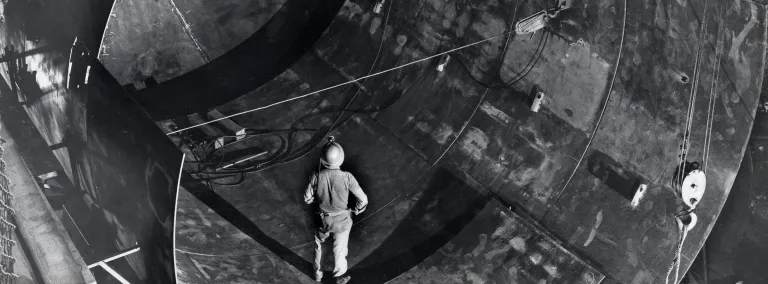
Davis Experiment
In 1965, Ray Davis began building a pioneering experiment deep underground at the Homestake Gold Mine in Lead, South Dakota. A chemist from Brookhaven National Laboratory, Davis designed his experiment based on a theoretical model developed by John Bahcall, then a postdoctoral fellow at CalTech. The 100,000-gallon tank built on the 4850 Level was filled with perchloroethylene (chlorine), a dry-cleaning fluid, to count and capture neutrinos from the sun—a method first suggested in the 1950s by Italian physicist Bruno Pontecorvo. The hypothesis suggested that when neutrinos interacted with the chlorine atoms, they would change into argon 37 (37Ar) atoms.
Davis’ fascination with neutrinos began at Brookhaven in 1948 when he read a review paper by H.R. Crane. “Thus began a long career of doing just what I wanted to do and getting paid for it,” he wrote in an autobiographical sketch for the Nobel Prize committee. Davis’ research initially took him to Brookhaven’s Graphite Research Reactor in New York and the Savannah River Plant in South Carolina. Then, in the late 1950s, he built a pilot experiment 2,300 feet underground in a limestone mine near Akron, Ohio. In 1965, he went deeper still—to Homestake’s 4850 Level.
Neutrinos, among the most abundant particles in the universe, go through matter like it isn't there—for a couple of reasons. First, they are unimaginably small—about a million times smaller than electrons. Second, they have no charge, so they don't interact with charged particles. Most neutrinos pass right through the earth.
Homestake excavated a cavern for Dr. Davis on the 4,850-foot level. The Davis experiment was far removed from the Homestake ore body and from the mine's infrastructure of tunnels and shafts, but it was close enough to the Yates Shaft to provide relatively easy access for researchers. The experiment itself was installed in 1965, with first results published in 1968. However, Davis’ experiment detected just one third the number predicted by Bahcall, thus creating the “solar neutrino problem.”
At first, the scientific community thought the experiment must be wrong, but Davis insisted he was right, as did Bahcall. Over the ensuing three decades, both Bahcall and Davis continued to refine the theory and experiment; still, the solution remained elusive. The two were vindicated when two neutrino experiments, Super-Kamiokonde (1998) and the Sudbury Neutrino Observatory (2000) confirmed the results of Davis’ experiment when they discovered that neutrinos oscillate, or switch between three types—muon, electron, and tau—as they race through space near the speed of light. Davis’ experiment could detect just the electron neutrino.
The solar neutrino detector at Homestake had turned out to be remarkably accurate, and in 2002 Ray Davis was awarded a share of the Nobel Prize for Physics “for pioneering contributions to astrophysics, in particular for the detection of cosmic neutrinos.” His pioneering work would also culminate in an American Physical Society Historic Physics Site designation for SURF in 2020.